Do you have a question about the MOTO GUZZI California and is the answer not in the manual?
Guidance on essential safety practices before operating the motorcycle.
Critical safety information regarding the hazards of carbon monoxide exhaust fumes.
Precautions for handling gasoline, its toxicity, flammability, and storage.
Warning about extremely hot engine and exhaust system components after use.
Guidance on proper engine warm-up procedures and safe riding practices.
Explanation of dashboard warning lights and their implications for engine and oil pressure.
Hazards associated with brake and clutch fluid, and necessary safety precautions.
Critical safety information regarding battery electrolyte and hydrogen gas hazards.
Procedure for reporting vehicle defects that could compromise safety to NHTSA and Moto Guzzi.
Declaration of the limited warranty for the emission control system for the USA market.
Overview of the dashboard layout, including instrument panel controls and their functions.
Description of the instrument panel display elements, including indicators and digital screen.
Explanation of the various indicator lights on the instrument panel and their meanings.
Explanation of various alarm icons and the need to consult a dealer for anomalies.
How the 'SERVICE' message and red alarm light indicate an abnormality.
Signals severe abnormalities with flashing lights and 'URGENT SERVICE' messages.
Explanation of oil pressure sensor and ECU disconnection alarm signals.
How to use the turn signal selector and interpret rapid flashing of indicator lights.
Description of the three selectable engine acceleration mappings: TURISMO, VELOCE, PIOGGIA.
How to select and adjust the MGCT system levels for traction control.
Description of the ignition switch positions (LOCK, OFF, ON, PARKING) and their functions.
Instructions on how to lock the handlebar and important safety warnings.
Operation of the high/low beam selector for daytime and nighttime riding conditions.
How to activate and use the cruise control system for maintaining selected speed.
Explanation of how ABS prevents wheel lock-up and improves vehicle stability during braking.
How the MGCT system controls rear wheel slip for enhanced vehicle stability.
Essential pre-ride checks for ensuring correct and safe operation, and when to contact a dealer.
Critical safety precautions for refueling, including flammability and ventilation.
Instructions for adjusting rear shock absorber spring preload for personalized ride height.
Periodic checks and adjustment procedures for the front fork.
Essential guidelines for the first 1000 km to ensure reliability and optimal performance.
Instructions for starting the engine, including use of the automatic starter and cold start procedures.
General safety rules and recommendations for riding, including protective clothing and legal requirements.
Key safety recommendations to prevent damage and injury during mounting/dismounting and riding.
Crucial procedure for checking engine oil level for safety and preventing engine seizure.
Detailed steps for checking engine oil level with a warm engine and correct dipstick usage.
Regularly checking tire pressure at ambient temperature and inspecting for wear.
Procedure for checking brake fluid level and identifying minimum/maximum marks.
Contact dealer for instructions on topping up brake system fluid.
Procedure for checking clutch fluid level and identifying minimum/maximum marks.
Referral to dealer or service manual for topping up clutch fluid.
Step-by-step guide for installing a new battery, including safety precautions for cable connection.
Guidelines for checking fuses, avoiding improper replacements, and identifying causes of blown fuses.
Warnings against using the vehicle if lights are not working perfectly or are misaligned.
Procedure for checking and adjusting the front headlight beam alignment.
Critical warnings about riding with worn or malfunctioning brakes and collision risks.
Procedure to check brake pad wear, including visual inspection and warnings about worn pads.
Detailed technical specifications of the engine, including type, displacement, compression, and timing.
Details on front and rear disc brake systems, including caliper and piston configurations.
Overview of recommended maintenance checks and services, including advice on reporting anomalies.
Guidance on essential safety practices before operating the motorcycle.
Critical safety information regarding the hazards of carbon monoxide exhaust fumes.
Precautions for handling gasoline, its toxicity, flammability, and storage.
Warning about extremely hot engine and exhaust system components after use.
Guidance on proper engine warm-up procedures and safe riding practices.
Explanation of dashboard warning lights and their implications for engine and oil pressure.
Hazards associated with brake and clutch fluid, and necessary safety precautions.
Critical safety information regarding battery electrolyte and hydrogen gas hazards.
Procedure for reporting vehicle defects that could compromise safety to NHTSA and Moto Guzzi.
Declaration of the limited warranty for the emission control system for the USA market.
Overview of the dashboard layout, including instrument panel controls and their functions.
Description of the instrument panel display elements, including indicators and digital screen.
Explanation of the various indicator lights on the instrument panel and their meanings.
Explanation of various alarm icons and the need to consult a dealer for anomalies.
How the 'SERVICE' message and red alarm light indicate an abnormality.
Signals severe abnormalities with flashing lights and 'URGENT SERVICE' messages.
Explanation of oil pressure sensor and ECU disconnection alarm signals.
How to use the turn signal selector and interpret rapid flashing of indicator lights.
Description of the three selectable engine acceleration mappings: TURISMO, VELOCE, PIOGGIA.
How to select and adjust the MGCT system levels for traction control.
Description of the ignition switch positions (LOCK, OFF, ON, PARKING) and their functions.
Instructions on how to lock the handlebar and important safety warnings.
Operation of the high/low beam selector for daytime and nighttime riding conditions.
How to activate and use the cruise control system for maintaining selected speed.
Explanation of how ABS prevents wheel lock-up and improves vehicle stability during braking.
How the MGCT system controls rear wheel slip for enhanced vehicle stability.
Essential pre-ride checks for ensuring correct and safe operation, and when to contact a dealer.
Critical safety precautions for refueling, including flammability and ventilation.
Instructions for adjusting rear shock absorber spring preload for personalized ride height.
Periodic checks and adjustment procedures for the front fork.
Essential guidelines for the first 1000 km to ensure reliability and optimal performance.
Instructions for starting the engine, including use of the automatic starter and cold start procedures.
General safety rules and recommendations for riding, including protective clothing and legal requirements.
Key safety recommendations to prevent damage and injury during mounting/dismounting and riding.
Crucial procedure for checking engine oil level for safety and preventing engine seizure.
Detailed steps for checking engine oil level with a warm engine and correct dipstick usage.
Regularly checking tire pressure at ambient temperature and inspecting for wear.
Procedure for checking brake fluid level and identifying minimum/maximum marks.
Contact dealer for instructions on topping up brake system fluid.
Procedure for checking clutch fluid level and identifying minimum/maximum marks.
Referral to dealer or service manual for topping up clutch fluid.
Step-by-step guide for installing a new battery, including safety precautions for cable connection.
Guidelines for checking fuses, avoiding improper replacements, and identifying causes of blown fuses.
Warnings against using the vehicle if lights are not working perfectly or are misaligned.
Procedure for checking and adjusting the front headlight beam alignment.
Critical warnings about riding with worn or malfunctioning brakes and collision risks.
Procedure to check brake pad wear, including visual inspection and warnings about worn pads.
Detailed technical specifications of the engine, including type, displacement, compression, and timing.
Details on front and rear disc brake systems, including caliper and piston configurations.
Overview of recommended maintenance checks and services, including advice on reporting anomalies.
| Displacement | 1380cc |
|---|---|
| Transmission | 6-speed |
| Front Suspension | Telescopic fork |
| Fuel Capacity | 20.5 liters (5.4 US gal) |
| Seat Height | 740 mm (29.1 in) |
| Fuel System | Electronic fuel injection |
| Final Drive | Shaft |
| Front Brake | Dual discs |
| Rear Brake | Single disc |
| Engine Type | V-twin |
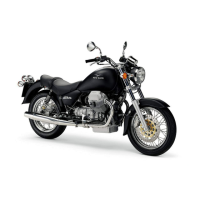

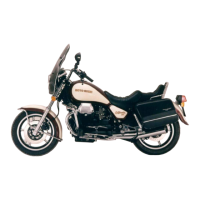
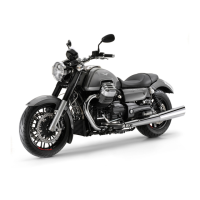
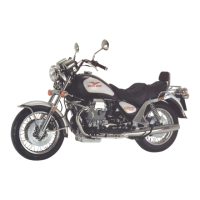
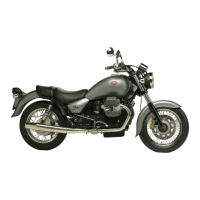
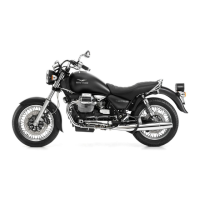
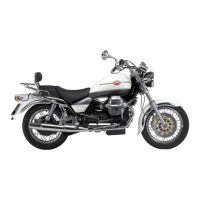

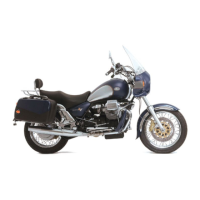
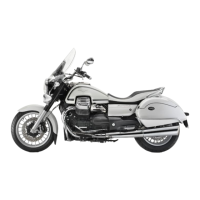
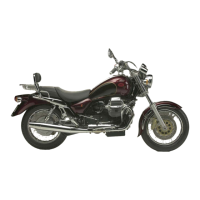
